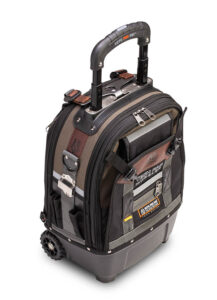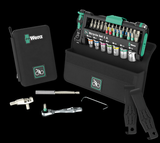Avoiding Injury Over Time: The Case for the Rolling Tool Bag
The story usually goes like this: It’s a Friday afternoon, and you’re wrapping up a job at a client’s house. Everything is going smoothly until go to haul your tool bag – that familiar yank on the lower back sends a shooting pain right up your spine. You either hobbled home or to the nearest urgent care. It’s not strictly just the tool bag that is the problem–years working any active job will do damage to one’s body–but the extra heavy load you carry on your back every day certainly doesn’t help.
According to this 2021 study on improper backpack use in teens, bags that exceeded the max payload caused chronic pain and injuries to teenagers, including musculoskeletal injuries. That’s just from carrying around textbooks; imagine the damage done to adults lugging around heavy tools and machinery. Statistics for construction laborers are even more grim: In 2022, 24.2 million hours were missed from full-time construction workers due to injury or illness. In 2020, workers missed an average of 11 days due to injury. Improper bag use, while seemingly not important, can be a source adding to these statistics and even force some skilled workers out of the trades altogether. It’s a story heard all too often, and it’s one we can help prevent.
THE WEIGHT OF YOUR TRADE
The constant strain of carrying a heavy bag can lead to several problems, including:
- Back Strain and Potential for Long-Term Injury: The repetitive motion of lifting and carrying a heavy bag puts immense stress on your lower back. This can strain muscles and ligaments, and over time, can lead to more serious injuries like herniated discs.
- Shoulder Pain and Discomfort: The weight of the bag can also put a strain on your shoulders, leading to pain, discomfort, and reduced mobility.
- Reduced Mobility and Agility on the Job Site: A heavy bag can slow you down and make it difficult to maneuver around the job site, especially on stairs or uneven terrain.
These issues can not only cause pain and discomfort, but they can also impact your productivity and even force you to take time off work.
THE CASE FOR THE ROLLING TOOL BAG
There’s a better way! Rolling tool bags are becoming increasingly popular among tradesmen, and for good reason. These innovative bags offer a healthy and efficient way to carry your tools.
The Benefits:
- Reduced strain: Rolling your tools eliminates the need to constantly lift and carry a heavy bag. This takes the pressure off your back and shoulders, reducing the risk of strain and injury.
- Increased productivity: Less pain and fatigue means you can focus on the job at hand. Easy access to your tools through well-organized compartments saves you time and keeps you productive throughout the day.
- Can Accommodate a Wider Variety of Tools: Rolling tool bags often come in larger sizes than traditional tool bags, allowing you to carry more tools with ease. This means fewer trips back and forth to your truck and less time wasted searching for the tools you need.
HOW TO CHOOSE THE RIGHT ROLLING TOOL BAG
A good rolling tool bag should be an investment in your health and career, so it’s important to consider your specific needs. Here are some key factors to keep in mind:
- Size and Weight Capacity: First, consider the typical load you carry. Rolling tool bags come in a variety of sizes, so choose one that can comfortably accommodate all your essential tools without being overloaded. Remember, even a rolling bag can be a strain if it’s too heavy.
- Compartmentalization and Organization: A well-organized bag with compartments and dividers will save you time and frustration on the job site. Look for a bag that allows you to easily categorize and access your tools, reducing the need for bending and digging around.
- Durability: A rolling tool bag is going to take a beating on the job site. Choose one that’s constructed with high-quality, durable materials that can withstand tough conditions. Consider features like reinforced stitching, water-resistant fabric, and a strong frame.
- Maneuverability: Think about the type of terrain you typically work on. Some rolling tool bags have larger, all-terrain wheels for easy maneuvering over uneven ground, while others may have smaller wheels better suited for smooth surfaces.
OUR PICK: THE VETO PRO PAC TECH PAC WHEELER

The Tech Pac Wheeler is the rolling version of the best-selling TECH PAC backpack tool bag. Designed with professionals in mind, this bag offers a seamless blend of functionality and ease of transport.
Features:
- 48 interior and exterior tool pockets
- Waterproof Polypropylene plastic base with integral wheels and trolley system
- Optional & stowable backpack shoulder harness
- Quick release metal hasp supports load & allows easy access to rear storage bay
- V-SWAP removable tool pocket panel system with alternate tool panels available & sold separately
- Thermoformed cushioned EVA back pad
- Metal YKK locking zippers
- Interior Gray pockets for better visibility
- Magnetic screw catcher
- 5-year Limited Warranty
The Tech Pac Wheeler is more than just a rolling tool bag; it’s an investment in your health and well-being. By choosing a functional and ergonomic like this, you can protect your back, improve your mobility on the job site, and boost your overall productivity. The option to switch from shoulder carry to rolling also reduces repetitive strain and provides you with more carry options.
OTHER CONSIDERATIONS: STRENGTHEN YOUR CORE!
While a rolling tool bag can significantly reduce the strain on your body, incorporating specific exercises into your routine can further strengthen your core and improve your overall well-being.
Here are a few exercises that are particularly beneficial for tradesmen:
- Plank: This simple yet effective exercise strengthens your core, back, and shoulders. Start in a push-up position with your forearms on the ground. Keep your body in a straight line from head to toe, engaging your core muscles. Hold for 30 seconds to 1 minute, and repeat 2-3 sets.
- Bird Dog: This exercise improves core stability and coordination. Start on all fours with your hands shoulder-width apart and knees hip-width apart. Extend one arm and the opposite leg out straight, keeping your back flat and core engaged. Hold for a few seconds, then switch sides. Repeat 10-12 repetitions on each side.
- Squats: Squats not only strengthen your legs and core, but they also mimic the lifting motion you do throughout the workday. Stand with your feet shoulder-width apart and toes slightly pointed outward. Lower yourself down as if you’re going to sit in a chair, keeping your back straight and core engaged. Push through your heels to return to standing position. Perform 2-3 sets of 10-15 repetitions.
- Lunges: Lunges work your legs, glutes, and core stability. Step forward with one leg, lowering your body until both knees are bent at 90-degree angles. Keep your front knee aligned over your ankle and your back heel lifted off the ground. Push through your front heel to return to standing position, then repeat with the other leg. Do 2-3 sets of 10-12 repetitions on each leg.
Remember, consistency is key! Aim to perform these exercises 2-3 times per week to see significant improvements in your core strength and overall well-being.
THE TAKEAWAY
As tradesmen, our bodies are our tools. Taking care of them is essential for a long and successful career. By investing in a quality rolling tool bag and combining that with a regular exercise routine, you can significantly reduce your risk of injury and ensure a long and healthy career in the trades.
Recent Posts
-
WERA Advent calendar 2025, 28 pieces
The 2025 Wera Advent calendar includes a comprehensive screwdriving workshop for the most common sc …2025 Nov 19th -
Wera Bicycle tool set
Bike tool set with ratchet, bits, sockets and a bitholding screwdriver in the very compact Tool-Che …2025 Jul 24th -
DUCT CARBON DIOXIDE TRANSMITTER
The duct CO2transmitter uses a highly accurate andreliable non-dispersive infrared (NDIR) sens …2025 Apr 3rd

